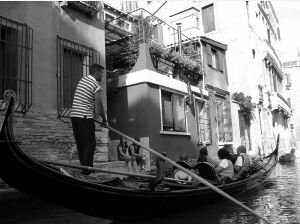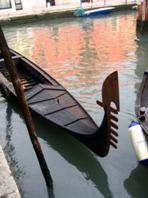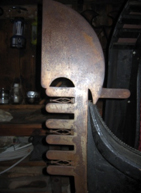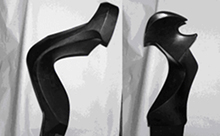Gondola

Although there are over 40 types of antique boats native to Venice, the gondola is most easily recognizable. Gondolas have not only become the symbol of Venice, but have also become a major interest to tourists, thereby creating a significant amount of revenue. The gondola is a very intricate and specific watercraft and has become what it is today through a long evolution as craftsmen perfected their building techniques.
The city of Venice developed as its people discovered the most efficient means of transportation within the city. Initially horses and other pack animals were used in Venice, but the maintenance of both horses and carriages strained the economics of both individuals and the community – considerations that brought back the ancient use of the boat as the primary means of transport. The most elegant means of water transportation was the gondola, named for the first time in 1094 by Doge Vitale Falier. It is believed that the name gondola was not initially restricted to the specific boat seen today, but that it was applied to different types of boats.
Evolution

Over time, the gondola evolved into the elegant boat that is recognizable today. It has gone through many modifications over the centuries, both in form and finer details. The first known description of a gondola, found in a 14th century manuscript, measured the boat 8 or 9 meters long (28 Venetian piedi or feet – 1 piede was 30.38 cm) (59). The original boat was not as slim as today’s gondola, perhaps because it was derived from the more common boats used for everyday tasks. The boat also lay more flat in the water; it did not have the banana-shaped curve as modern gondolas do. Although it has been continually improved and modified, many of the original technical terms are still used today, so that features of the ancient boats have remained intact.
The modern gondola has very specific measurements and specifications. The outer length is 10.85 meters, with an average width of 1.40 meters and a net weight of about 350 kilograms. Made up of around 280 wooden pieces, the gondola uses a variety of wood in its construction, including oak, fir, walnut, cherry-wood, larch, elm-root, and limetree. Despite modern techniques, the wood used for the sides of the gondola is curved using an ancient process that involves using marsh canes to heat the wood until it can be curved, which gives the gondola amazing balance although the gondola may appear likely to topple over at any moment.
Many different craftsmen contribute to the beautiful creation of a gondola. These craftsmen include carpenters, squerioli, and caulkers who tar the boats.The gondola is special, not only because of its unique shape, but also because of el parecio: its ornamentation. The most important of this ornamentation is the ferro, the forcola and remo, and the felze.
Ferro, Forcola, and Felze

The ferro is the distinctive metal design at the prow, or front, of the gondola. The ferro has gone through over 1,000 modifications since its creation; the curled design is not only for aesthetic reasons, but also to defend the gondola from possible damage caused by collisions. The ferro was once made from soft iron, but modern ferros are made with duralumin or other alloys - depending on the metal used, the ferro’s weight can vary from 10 to 20 kilograms. The unique shape of the ferro is famous worldwide – popular tradition maintains that the six teeth represent the six districts of Venice; the elegant curve signifies the Doge’s cap, or the Grand Canal. The semi-circular break between the curved top and the six teeth is said to represent the Rialto Bridge. The ferro has become a symbol of the gondola, which is, in turn, a symbol of Venice itself.
The remo (oar) and forcola (oarlock) are two of the most practically important parts of the gondola. The forcola is carefully shaped with a large bend for maximum strength and made from a single piece of walnut root. (43) The forcola is placed at the stern of the gondola, where it allows the boat to lean and lower on the right-hand side. The main function of the forcola is to support to the oar as the gondolier pushes on the oar to propel the gondola forward.
The remo, or oar, is specially made by the remer (oarmaker), who exclusively builds oars and oarlocks. The wood used is split beech, well-matured and without knots. The oar is carefully made to have a tapered blade at the end; the thickness of the oar gradually diminishes, which allows the oarsmen to row more effectively. Without these beautifully crafted pieces, a gondolier would not be able to row the gondola.

Another important, but now extinct, aspect to the gondola is the felze, which was a small cabin in the middle of the boat. The felze was initially made of small planks formed into an arch shape and covered with branches and ferns, or “felci”, from which the word “felze” is derived. The felze was later developed into a more richly decorated seating area as the use of the gondola became more popular with the wealthy nobility. The felze became “a small, floating drawing-room, with velvet or brocade seats inside and a little door at the front part and curtains on the small side windows." Over time, however, use of the felze diminished. Today they are never used on gondolas and exist only in private collections.
The Color Black
One of the peculiarities of the gondola is the fact that it is black. This might not seem strange at first, but it is interesting to note that every gondola in Venice is black. Once, gondolas were painted various colors, but black was prevalent because it is a sign of elegance and therefore suitable for every kind of big event. Although many associate the color black with mourning, the Venetian Republic used red as the symbol of mourning, while black was that of elegance. There are many theories as to why the gondola are now all black, with some being more realistic than others. One such theory is that the color black symbolizes mourning after the fall of the Venetian Republic in 1797 (this theory can be dismissed as there is no historical proof). Another version is that black was the established color after the plague disaster of 1630, which claimed over 50,000 lives. Most likely, the color derives from the use of black pitch used to seal the boat and make it waterproof.
The Gondolier
It is hard to discuss the gondola without mentioning the gondolier. These people have as long and rich a history as the boats themselves. “History shows that from simple boatmen they went on to become virtual ambassadors of high lineage, because of the secrets they knew about entire families of the nobility.” In the very early days of the gondola, the gondoliers were made up of Moors and black slaves. As the use of the gondola became more important, the gondoliers became an integral part of society. A gondolier’s daily contact with the aristocracy caused his rise in society and gondoliers eventually became the link between nobility and the common people. Gondoliers were connected to all of the events of the Republic and were also responsible for keeping the secrets of the nobility, as illicit affairs and intrigues would often occur on gondolas. In the late 1500s, when personal luxury in the gondola was forbidden, the gondoliers’ uniforms were required to be simple and sober. It was for this reason that they wore simple black up until World War II, when the influence of the French Army altered the uniforms. Today, gondoliers can be seen wearing blue and white or red and white striped shirts, a sight that has become a familiar part of Venetian culture.
External Links
References
- The Boats of Venice. Venezia: Libreria Editrice, 1999. Print.
- Bigda, Bryan, Michelle Dubuke, Daniel LaTorella, and Jennifer Richards. Museo Arzanà: Preserving the Traditional Boats of Venice. Interactive Qualifying Project, Worcester Polytechnic Institute, 2007.
- Candlish, Sean, Craig Shevlin, and Sarah Stout. The Traditional Boats of Venice: Assessing a Maritime Heritage. Interactive Qualifying Project, Worcester Polytechnic Institute, 2004.
- Catalano, Brian, Kristen Gervais, and Ryan Sinapius. Preserving the Nautical Traditions and Maritime Heritage of Venice, Italy. Interactive Qualifying Project, Worcester Polytechnic Institute, 2005.
- "The Gondola, Its History and Usefulness." Sito Ufficiale Della Gondola Veneziana. Web. 12 Oct. 2010. <http://www.gondolavenezia.it/history.asp?Capitolo=9>.
| |||||